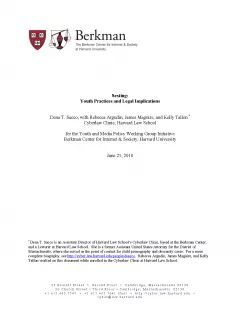
Sexting: Youth Practices and Legal Implications
Introduction
This document addresses legal and practical issues related to the practice colloquially known as sexting. It was created by Harvard Law School’s Cyberlaw Clinic, based at the Berkman Center for Internet & Society, for the Berkman Center’s Youth and Media Policy Working Group Initiative. The Initiative is exploring policy issues that fall within three substantive clusters emerging from youth’s information and communications technology practices: Risky Behaviors and Online Safety; Privacy, Publicity and Reputation; and Youth Created Content and Information Quality. The Initiative is funded by the John D. and Catherine T. MacArthur Foundation and is co-directed by danah boyd, Urs Gasser, and John Palfrey. This document was created for the Risky Behaviors and Online Safety cluster, which is focused on four core issues: (1) sexual solicitation and problematic sexual encounters; (2) Internet-related bullying and harassment; (3) access to problematic content, including pornography and self-harm content; and (4) youth-generated problematic content, including sexting. The Initiative’s goal is to bring the best research on youth and media into the policy-making debate and to propose practical interventions based upon that research.
This document is intended to provide background for discussion of interventions related to sexting. It begins with a definition of sexting, and continues with overviews of research and media stories related to sexting. It then discusses the statutory and constitutional framework for child pornography and obscenity. It concludes with a description of current and pending legislation meant to address sexting.
You might also like
- communityForces for Change

